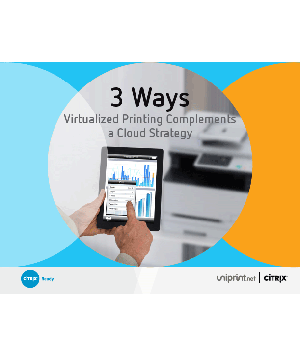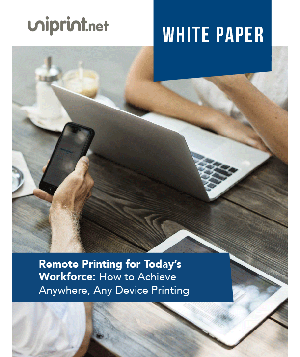Addressing Cloud Based Printing Services and Security
Printing and the cloud are seemingly at opposite ends of an organization’s infrastructure spectrum. Printing remains one of the last bastions of an organization’s infrastructure that cannot be completely virtualized, since the whole point of printing is to take something virtual and make it physical.
The cloud allows businesses to be more efficient, and printing should be one of those business processes, maybe even the most basic business process that could be simplified with the cloud.
The big benefit of cloud printing is that it drastically simplifies intra-organizational printing structures and flattens the complexities of coordinating hardware across a widely distributed system of computers. Of course, not all cloud printing is created equal, and – as with any new technology – the cloud brings with it a slew of new challenges.
Among these are the differences between public and private cloud printing and the ease of implementation to achieve these benefits. Figuring out these differences is central to understanding how to successfully implement a cloud-printing solution for your organization.
Cloud printing is particularly useful for large organizations with complicated computer network infrastructures such as government agencies, financial corporations and healthcare organizations. Many of these institutions connect hundreds (if not thousands) of devices and printers, sometimes across multiple locations.
As work becomes more mobile, an employee may need to print from multiple locations in different parts of a building or of a country. Struggling with installing different printer drivers each time an employee needs to print from a new printer is not just annoying, but also time-consuming and a drain on productivity.
Public cloud printing services can smooth out some of these snafus. They connect printers to the Web so that they can be accessed from anywhere and at anytime from Web-connected devices. Instead of installing unique drivers for every new printer, you could print from anywhere, as long as both the printer and the device are linked to the cloud printing service.
Even more, with cloud printing services, you could print from virtually any device that can connect to the service – including tablets and mobile phones.
However, many times, organizations also have high levels of security concerns that preclude them from using a public cloud. And, the problem with many third-party cloud printing services is that they use the “public” cloud.
While these cloud printing options do simplify the printing process, all the print data must travel through the public cloud as it makes its journey from device to printer.
Many organizations such as government agencies, financial corporations or healthcare organizations do not use public cloud services for the expressed reason that it is public.
Though some public cloud services have a privacy policy and a guarantee in place, many organizations need greater control and oversight of the sensitive data they handle.
Moreover, these organizations are also often large enough to merit their own clouds. As such, they prefer to create in-house private clouds so that they can leverage the advantages of cloud services while also maintaining their own security over sensitive data.
But implementing a private cloud printing solution has its own complications. Consider the infrastructure of government agencies as just one example. Every agency has its own structure for printing, each with active directories, and hundreds of thousands of users dispersed over wide geographic areas.
Consolidating printing in this situation requires aligning all the printers, drivers, devices, and users within the system – something that can’t be done easily or efficiently. Even more, this system is routinely bogged down with driver updates creating a giant logistical headache.
Every device needs to be updated for every driver update for every printer when the updates crop up. For the devices that don’t have printer drivers? Those will never be able to print at all. As such, a great resolution to this organizational hazard is to deploy a universal printer driver solution that can seamlessly connect and manage all printers within complex enterprise environments.
Institutions on the scale of multiple government agencies, whether they’re on the local, state or federal level, manage more printers than are easily handled in list form – though, truthfully, in comparison to public cloud printing, private clouds handle far fewer printers, which also makes them a better option for enterprises.
Either way, the printers need a structure that ensures users can identify the right printer without extraneous hassle. The structure should require as little effort on the user’s part as possible, so this particular iteration of cloud services must keep the location in mind.
Printers should automatically connect to whatever network makes the most sense (like the library in a university or the particular building a printer is attached to) so that only a few printers out of all the printers in the cloud get exposed to each user based on localities.
Cloud printing seems like a solution to the headache that is consolidating the vast multiplicity of printers in large and sprawling institutions. However, this solution may create more problems than it solves in its implementation.
Instituting cloud printing for many organizations is not as simple as ceding the reins to a public cloud service company. The particular security concerns of government agencies, financial corporations, healthcare providers and other security-sensitive institutions make public cloud solutions impossible.
Private cloud solutions, on the other hand, are complex puzzles that are difficult to administer. The right solution must be implemented to effectively address the complicated infrastructures of institutional printing while also ensuring that user access to printers is as easy and secure as possible. Without that, cloud printing would just replace one problem with another.
















